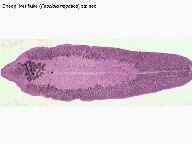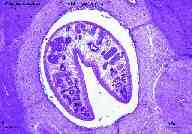Trematodes - The Flukes
Intestinal Parasite Infections From Flukes -- Description, Diagnosis, Treatment
Trematodes (or flukes) are flat worms that cause significant morbidity in human hosts. These parasites have complex life cycles involving multiple generations and hosts. Trematodes causing significant human disease include Fasciolopsis buski, the heterophyids (Metagonimus yokogawai and Heterophyes heterophyes) and the amphistomes (Gastrodiscoides hominis).
Many flukes are microscopically small, but some species grow to 2” - 3” in length. The following pictures portray a few of the larger intestinal and liver flukes. The left picture is an intestinal fluke, the middle and right pictures are liver flukes. The right picture is a sheep liver fluke encysted in a liver bile duct -- uncoiled it would be about 1 inch long.



FASCIOLOPSIS BUSKI
F. buski is the largest trematode to infect man and is commonly found throughout central and southeast Asia.
Life cycle. F. buski commonly infects both humans and pigs. Eggs are passed in the host feces and hatch in freshwater into miracidia. The miracidia are ingested by snails and develop into cercariae. The cercariae are passed by the host snail and encyst upon a variety of water plants including red caltrop, water chestnut, water bamboo, and water lotus. Humans ingest the shoots of these plants that contain as many as 200 metacercariae. The metacercariae migrate into the human duodenum and jejunum and attach to the intestinal mucosa. The adult worm develops within approximately 3 months.
Clinical manifestations. The majority of infections caused by F. buski are asymptomatic. When present, initial symptoms are usually abdominal pain and diarrhea. Severe infection, characterized by a heavy worm load, may be associated with severe non-bloody diarrhea, anemia, facial edema, peripheral edema, ascites, and intestinal obstruction. Erosion into the intestinal wall can lead to mucosal ulceration, GI hemorrhage, and/or abscess formation. Absorption of toxic metabolites may lead to the development of systemic symptoms.
Diagnosis, treatment, and prevention. The diagnosis is made by identification of typical eggs in the host feces, where occasionally, adult worms are passed. The treatment of choice is 75 mg/kg of praziquantel given in three divided doses over a single day. Infection with F. buski can be prevented with the boiling of freshwater vegetables and nuts prior to ingestion.
HETEROPHYIDS
Humans are infected by the small flukes Metagonimus yokogawai and Heterophyes heterophyes by eating raw fish.(35) Both M. yokogawai and H. heterophyes are primarily intestinal flukes of dogs and cats. Human infection with M. yokogawai occurs in Asia, the Middle East, and Siberia. H. heterophyes infection occurs in southeast Asia and northwest Africa.
Life cycle. The life cycles of M. yokogawai and H. heterophyes are identical. Eggs are ingested by snails that are the first intermediate hosts. The eggs mature into cercariae and are passed by the host snail. The cercariae penetrate the skin of freshwater fish and migrate to the muscle where they mature into metacercariae. Infected raw fish are ingested by humans. The metacercariae mature into adult worms in the duodenum and jejunum.
Clinical manifestations. The majority of M. yokogawai and H. heterophyes infections are asymptomatic. Abdominal pain and diarrhea may accompany severe infection. Occasionally, eggs may penetrate the intestinal mucosa and reach the intestinal lymphatics where migration into the heart or central nervous system can occur. Granulomatous reaction may result from this migration; however, symptoms are distinctly uncommon.
Diagnosis, treatment, and prevention. The diagnosis is made through the identification of typical eggs of M. yokogawai or H. heterophyes in the host feces. Treatment of these flukes is the same as that for F. buski. Infection with these worms can be prevented with proper cooking of fish prior to ingestion.
AMPHISTOMES
Gastrodiscoides hominis is a common parasite in humans in India and the former Soviet Union, where it is prevalent in pigs. Humans become infected through ingestion of infected plants.
Life cycle. The life cycle of G. hominis is not completely known but is believed to be similar to that of F. buski, with snails and aquatic plants acting as intermediate hosts.
Clinical manifestations. Most infections are asymptomatic. Severe infection is associated with abdominal pain and diarrhea.
Diagnosis, treatment, and prevention. The diagnosis is made through the identification of typical eggs in the host feces. Treatment is the same as that for M. yokogawai or H. heterophyes. Soapsuds enemas have been reported to be as effective as chemotherapy in removing the worms.
Source: Dr. David Bernstein, M.D.




